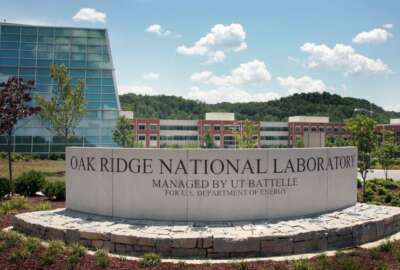Hubbard Radio Washington DC, LLC. All rights reserved. This website is not intended for users located within the European Economic Area.
On Air: Federal News Network
Trending:
A national lab wants to make complex chemistry problems a little more solvable
Computational chemistry may not be at your top concern, but in reality, it's a key to solving some of the world's biggest problems. It takes a massive amount ...
Computational chemistry may not be at your top concern, but in reality, it’s a key to solving some of the world’s biggest problems. It takes a massive amount of computing power, something not everyone has had access to until now. The Pacific Northwest National Laboratory (PNNL) is collaborating with Microsoft Corp. and Micron Technology to make computational chemistry broadly available to applied researchers and industrial users. For more, Federal Drive with Tom Temin‘s Eric White spoke with the PNNL scientist leading the effort, Karol Kowalski.
Interview Transcript:
Karol Kowalski So we are trying to bring a new form of executing high performance computational chemistry software on cloud computing. These are a new way of approaching exascale resources and performing high level simulations for chemistry needs. So this is at the nexus of theory, computation, high performance computing and technology. So we basically bring together the teams of the computational chemists, competition on theoretical chemists, computer scientists, and the industry. We are connecting our software with the new technological advances of Microsoft and Micron, which allows us to perform really large scale calculations of the costs in an energy efficient manner. This is very important because scientific calculators, simulations do not come for free. We have to pay for many, many aspects of this process. So we hope to achieve this goal by migrating to cloud computing.
Eric White And what exactly does that involve when you’re doing so many calculations via cloud computing? You know, I naturally just think of, wow, that’s a lot to be done on the cloud, but I guess it can handle it.
Karol Kowalski That’s a very interesting process in the same way, very complicated, because what is a cloud computing? First question, it’s kind of pool of the interconnected hardware resources, this might be a server, this might be a computational unit, this might be storage devices. So we have to come up with the algorithms that can make those pieces of the hardware talking to each other to achieve the performance, which is pretty close to those exascale machines right now supported by DoE. So they are mostly located at plus supercomputing centers. But of course, getting access to those machines is really hard. And this is a bottleneck for broad optimization of the computational chemistry software. So we are trying to address this issue in our project. This might be very important. I mean, aspect of this proposal. We want to provide some kind of democratize access to the Y community of the computational chemist to supercomputing resources. But this is very important.
Eric White Yeah. And about that bottleneck. So, you know, there are a myriad of projects I imagine that the government supercomputers are being utilized for and they’re being kept busy. Is that one of the main reasons for reaching out for an industry partner such as Microsoft and Micron?
Karol Kowalski That’s a very good question. So basically we believe that with this new technology with just looks on the horizon. So I’m talking about the high performance cloud model by Microsoft and new types of memory systems developed by Micron. We can develop a new class of simulations for the chemistry. We can really operate, we can bring to the picture a very novel ways of utilizing machine learning algorithms which wouldn’t be possible if we only relied on the supercomputing resources like Exascale Machine in Oregon or Oak Ridge. We need to have a steady access to the big machines, to basically build those models.
Eric White And you want to be able to jump to the front of the line.
Karol Kowalski That’s exactly the point. So basically what we want to achieve through this cloud computing, the merger of the state of the art methods and the cloud computing we really want to achieve unprecedented level of accuracy in our predictions, which is really necessary to describe chemical processes, which are very important for not only for the industry, but also for the national economy and for the nation state.
Eric White Yeah, So let’s get down to the actual project itself. Now that we’ve gotten set the scene sort of. Computational chemistry, not a term that many people use and you’re trying to get it out more into the forefront of everybody’s day to day lives. Can you just explain to me what it is? I imagine it’s just instead of actually pouring the chemicals from a test tube, you’re actually you’re just having the computer say, actually this is what would happen.
Karol Kowalski I will be trying to give you all the answer as I can. But computational chemistry, what we mean is a set of algorithms which are deeply rooted in the postulates of quantum mechanics, because quantum mechanics really governs most of them. Let’s put this, 99% of that of the process as we are interested in. So computational chemists trying to describe the properties and behavior of molecules of chemical processes, using those laws of the quantum mechanics. So how it looks in practice, those laws, equations are translated into the codes, and my main interest is the develop of the codes, which can help us in in minimizing the time to solution. We don’t want to wait years or decades to get the number, one single number, for example. We want to get this information within maybe day, within maybe hours, and if we have big machines or supercomputers or high performance cloud. This is the goal, to get answer as quickly as we can. So as I said, this is a very complex problem to solve. And there are several aspects which have to be addressed. At the same time this is a kind of challenging part of the project because we are involved so many aspects. We have to address so many aspects to make it working, that this will require the concerted effort of the group of 30 people, around 30 people.
Eric White And something that could shorten that timeline I imagine are the are AI and machine learning aspects of Microsoft’s and Micron Systems. What role will they be playing in this process?
Karol Kowalski Exactly. So this is a very interesting workflow because we should see this as a workflow. So we are using each technology for a different purpose. We are planning to use the Microsoft high performance cloud to generate high quality, high accuracy data for machine learning and AI procedures while the whole training machine learning algorithms are going to be executed using the Micron technology. They came up with the kind of novel solution for the memory, computer memory, and if you want really to train using this ML machine learning models effectively, you’ll have to be able to process a huge amount of data and it takes a lot of memory. Now, Micron has this new technology which offers a huge memory we can play with and we can get pretty fast access of data residing in that memory. So this is kind of a game changer. We put all those pieces together. I guess we can define some new form of the chemical simulations. We actually have a name for that. This is computational chemistry as a service. So many groups without access to supercomputing resources can use the service to perform, not scale calculations.
Eric White So look in a timeline here. What are we looking at as far as, you know, people coming to you and saying, hey, I have this highly complex algorithm and problem that I’m looking to try and put into a supercomputer and see what see what kind of chemistry happens from it. Are we at that stage currently or have we reached it yet? What are we looking at here?
Karol Kowalski So we are in that kind of prototyping phase. There are several things we have to really address before we go abroad broadly with the growth of, for example, code development. But we also have what we really want to achieve in two years. We would like to make the infrastructure ready for the people to chime in. So basically use as a sandbox for all the people who are really in the simulation and chemical processes. And so the first two years will focus mainly to provide efficient tools to make sure that we provide the most efficient version of those cloud systems. And then once we have the optimized infrastructure, we’ll let people to use it. So we have two group of users, the developers who will be able to use cloud computing for development of the models and the other parts of users are the application scientists, which will be using the software we are going to enable on the cloud to run a large scale simulation.
Copyright © 2024 Federal News Network. All rights reserved. This website is not intended for users located within the European Economic Area.
Eric White
Eric White is news anchor and Federal Drive producer at Federal News Network.
Follow @FEDERALNEWSCAST





